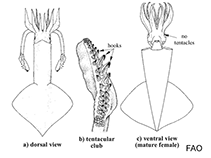Moroteuthopsis ingens (Smith, 1881)
Greater hooked squid
Upload your photos
Google image | No image available for this species;
drawing shows typical species in Onychoteuthidae.
Google image | No image available for this species;
drawing shows typical species in Onychoteuthidae.
Classification / Names প্রচলিত নাম সমূহ | প্রতিনাম সমূহ | CoL | ITIS | WoRMS
Cephalopoda | Oegopsida | Onychoteuthidae
Environment: milieu / climate zone / গভীরতার পরিসীমা / distribution range বাস্তুসংস্থান
ভাসমান; গভীরতার পরিসীমা 0 - 1025 m (সূত্র 2123), usually 0 - 200 m (সূত্র 2123). Polar; 30°S - 63°S, 180°W - 180°E (সূত্র 275)
Distribution দেশ সমূহ | এফ এ ও এলাকাসমূহ | বাস্তুতন্ত্র | দৃষ্টিগোচর | প্রচলন
Southern Ocean: in sub-Antarctic waters north of the convergence.
Length at first maturity / আকৃতি / Weight / Age
পরিপক্কতা : Lm ? range ? - ? cm Max length : 94.0 cm ML পুরুষ/ লিঙ্গ অনিধর্ারিত ; (সূত্র 275)
Reported from the epipelagic zone to deepwater demersal habitats through ontogenetic migration. Females spawn at depths greater than 700m in New Zealand and Falkland Island waters. Reportedly exhibits cannibalism in Falkland Island waters (Ref. 128994).
Life cycle and mating behavior পরিপক্কতা | প্রজনন | ডিম ছাড়া | Eggs | ডিম্বধারন ক্ষমতা | Larvae
Members of the class Cephalopoda are gonochoric. Male and female adults usually die shortly after spawning and brooding, respectively. Mating behavior: Males perform various displays to attract potential females for copulation. During copulation, male grasp the female and inserts the hectocotylus into the female's mantle cavity where fertilization usually occurs. Life cycle: Embryos hatch into planktonic stage and live for some time before they grow larger and take up a benthic existence as adults.
Main reference
সূত্র সংখ্যা | সমম্বয়কারী | সহযোগী
Roper, C.F.E., M.J. Sweeney and C.E. Nauen. 1984. (সূত্র 275)
IUCN Red List Status
(সূত্র 130435: Version 2024-2)
Least Concern (LC) ; Date assessed: 10 May 2010
CITES status (সূত্র 108899)
Not Evaluated
CMS (সূত্র 116361)
Not Evaluated
Threat to humans
Human uses
মৎস্য: সম্ভাবনাময় আকর্ষণ
FAO - মৎস্য: landings | FishSource |
হাতিয়ার
আরো তথ্য
ট্রফিক বাস্তুতন্ত্র
বাস্তুসংস্থান
Population dynamics
বৃদ্ধি
Max. ages / sizes
Length-weight rel.
Length-length rel.
Length-frequencies
Mass conversion
নির্বাচন
প্রাচুর্য
Max. ages / sizes
Length-weight rel.
Length-length rel.
Length-frequencies
Mass conversion
নির্বাচন
প্রাচুর্য
Life cycle
Distribution
Human Related
Aquaculture profiles
Stamps, coins, misc.
Stamps, coins, misc.
Outreach
Taxonomy
সূত্র সংখ্যা
ইন্টারনেট সুত্র
BHL | BOLD Systems | CISTI | DiscoverLife | FAO(মৎস্য: ; publication : search) | Fishipedia | GenBank (genome, nucleotide) | GloBI | Gomexsi | Google Books | Google Scholar | Google | PubMed | জীবন বৃক্ষ | Wikipedia (Go, অনুসন্ধান ) | জুলজিকাল রেকর্ড



